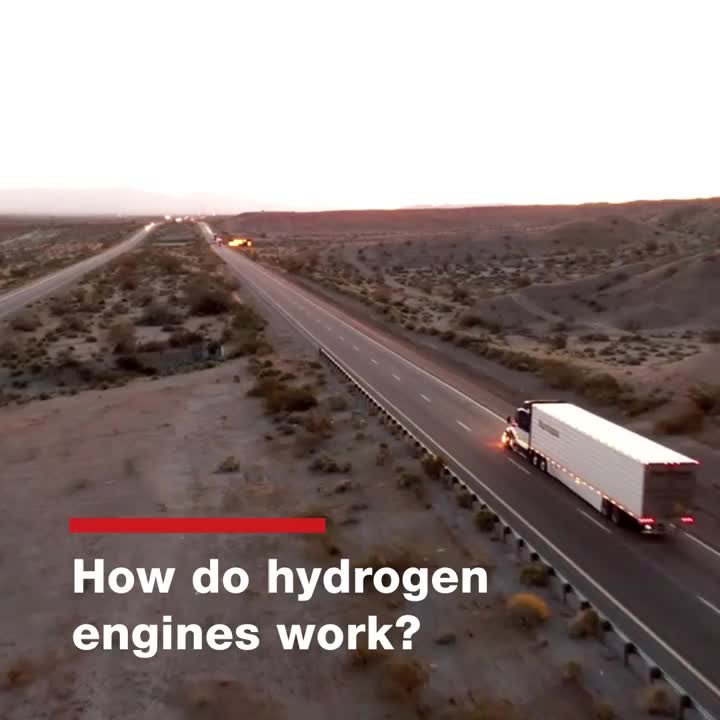How do hydrogen engines work?
Hydrogen is an increasingly popular energy carrier. It can be readily produced from water using renewable electricity, and it burns without any greenhouse gas emissions. It is colorless, odorless, and does not spill. It’s no wonder there is a great interest in hydrogen engines as a part of destination zero.
By Jim Nebergall, General Manager of the Hydrogen Engine Business

How can hydrogen fuel power a vehicle?
Using hydrogen to power an engine or motor is more straight forward than you might think. There are two ways to do this.
The first way involves a device known as a fuel cell. The fuel cell converts hydrogen to electricity, which then powers the vehicle’s electric motors, just like in any electric vehicle.
The other way is hydrogen engines; internal combustion engines that burn hydrogen as the fuel. Either method has its advantages and applications where they are best suited. However, the latter, using internal combustion engines is a more familiar technology.
In fact, one of the very first internal combustion engines ran on a mixture of hydrogen and oxygen—and featured an electric spark ignition mechanism. Its inventor, a former Swiss artillery officer named François Isaac de Rivaz, used it to build a vehicle that could carry heavy loads over short distances.
Diesel engine vs. natural gas engine vs. hydrogen engine
Today, if you saw a modern internal combustion engine designed to run on hydrogen, you might not know that it’s not meant for natural gas. Four-stroke hydrogen internal combustion engines (Hydrogen ICE) operate on the same cycle as regular natural gas engines and have almost the same components—engine block, crank, cylinder heads, ignition system, installation parts, and so on.
Diesel engines and hydrogen engines also share similar components. These include an engine block, crank, and installation parts such as mounts and flywheel housings.
At Cummins Inc., we are leveraging our existing platforms and expertise in spark ignited technology to build hydrogen engines. Our hydrogen engine is a spark ignited engine variant with similar engine hardware to natural gas and gasoline engines.
This high commonality among engine components introduces scale advantages. This economies of scale is critical in the transportation sector’s journey to lower emissions. It reduces costs and delivers the needed reliability.
There are also differences between hydrogen engines and other spark ignited engines such as natural gas and gasoline engines.
For example, differences in the physical properties of hydrogen impacts how fuel and air are metered and injected. Pre-ignition is a greater problem for hydrogen engines than for gasoline engines, because hydrogen is much easier to ignite. Direct injection is one way to overcome pre-ignition issues. Direct injection systems introduce fuel–hydrogen, in this case –directly into the cylinders, rather than into the intake manifold or ports. If the injection takes place at a time when the inlet valve is closed, backfire conditions are avoided. Another solution is to completely design the combustion system for hydrogen.
Another consideration is the formation of nitrogen oxides, or NOx. NOx is an atmospheric pollutant which can cause poor air quality and lead to the brown-orange haze that forms above some large cities in the summer.
When hydrogen burns in the presence of lots of oxygen, very little NOx is formed. However, when hydrogen burns with air fuel ratios that are near stoichiometric, a significant amount of NOx can be created. As a result, hydrogen engines are typically tuned to run lean with an excess air ratio of 2 or greater. This means that approximately twice as much air needs to be supplied to the cylinders than for a stoichiometric engine. Hydrogen engines often require an exhaust treatment system to remove this excess NOx.
Can hydrogen engines work in medium and heavy-duty trucks and buses?
Hydrogen internal combustion engines are appealing to vehicle makers for two primary reasons. First is their similarity with traditional internal combustion engines. Second is hydrogen’s ability to power vehicles as a zero-carbon fuel.
An original equipment manufacturer (OEM) can build vehicles with hydrogen engines that are very similar to existing internal combustion engines. Most of the vehicle’s other components and software remain the same.
Hydrogen engines are also attractive to end users. Hydrogen engines look, sound and work like the internal combustion engines that every mechanic in the world is used to. Their reliability and durability are equal to that of diesel engines.
Cummins is currently testing hydrogen engines to mitigate the risks of hydrogen embrittlement and erosion. We will share our findings as our tests progress.
Commercial fleet operators can purchase vehicles featuring hydrogen engines without the anxiety that might come from investing in a brand new technology.
Examples of hydrogen engines in the mobility and transportation sectors also go beyond medium and heavy-duty trucking. You can find users evaluating hydrogen engines in marine, construction, and beyond.
So, you might not know immediately that a vehicle is designed for hydrogen if you saw its engine, but if you saw its fuel tank, you would know right away. Storing hydrogen onboard motor vehicles is safe and becoming more economical and practical. Cummins has recently formed a joint venture with NPROXX, a leader in hydrogen storage and transportation for hydrogen storage tanks. This joint venture will provide customers with hydrogen and compressed natural gas storage products for both on-highway and rail applications.

Never miss the latest and stay ahead. Sign-up below to receive the latest in technologies, products, industry news, and more.
Author Profiles

Jim Nebergall, General Manager of the Hydrogen Engine Business
Jim Nebergall is General Manager of the Hydrogen Engine Business at Cummins Inc. and leads the company’s global efforts in commercializing hydrogen-fueled internal combustion engines. Hydrogen internal combustion engines are an important technology in the company’s accelerated path to decarbonization. Jim joined Cummins in 2002 and has held numerous leadership roles across the company. Most recently, Jim was the Director of Product Strategy and Management for the North American on-highway engine business. Jim is passionate about innovation and has dedicated his Cummins career to advancing technology that improves the environment. He pushed the boundaries of customer-focused innovation to position Cummins as the leading powertrain supplier of choice, managing a portfolio ranging from advanced diesel and natural gas to hybrid powertrains. Jim graduated from Purdue University with a bachelor’s degree in electrical and computer engineering. In 2007, he completed his Master of Business Administration degree from Indiana University.
Related Topics
Related Tags